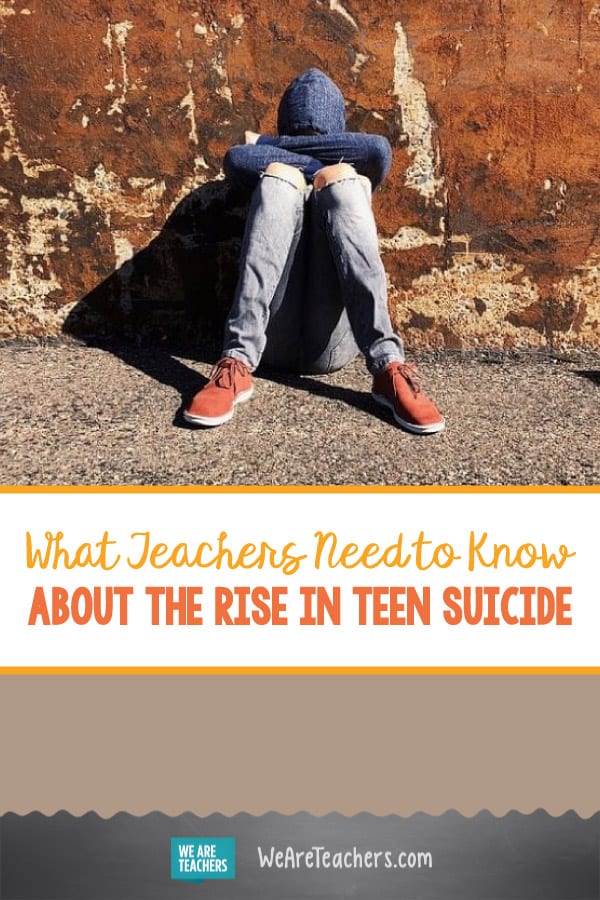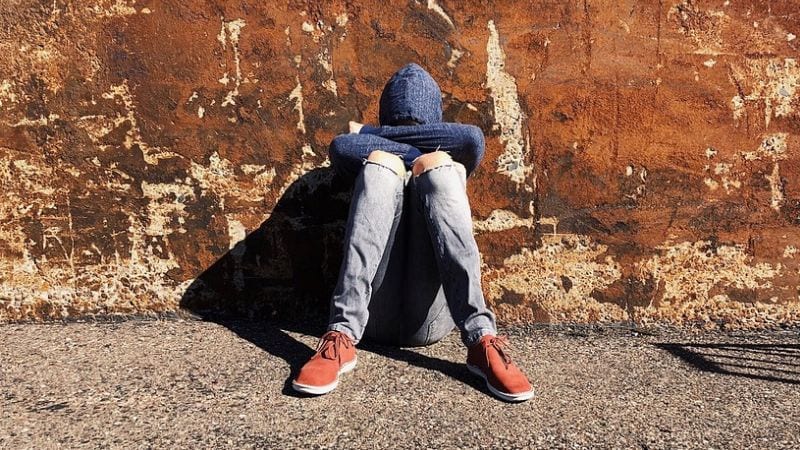You’ve probably seen the news: Child and teen suicide numbers have been increasing in the United States over the last 20 years. The Washington Post highlighted this issue recently in a thoughtful and well-researched piece that every teacher and parent should read. Suicide, especially among kids, is a difficult topic. To help teachers understand and address it, we’ve put together some of the most important information on teen suicide, including how to recognize and prevent it.
Please note: Child and teen suicide is a sensitive and complicated issue. The info and resources here are just a beginning. Please work with mental health professionals to answer any questions you have or to get help for your students or yourself.
Know what to do if you suspect a student is at immediate risk for suicide.
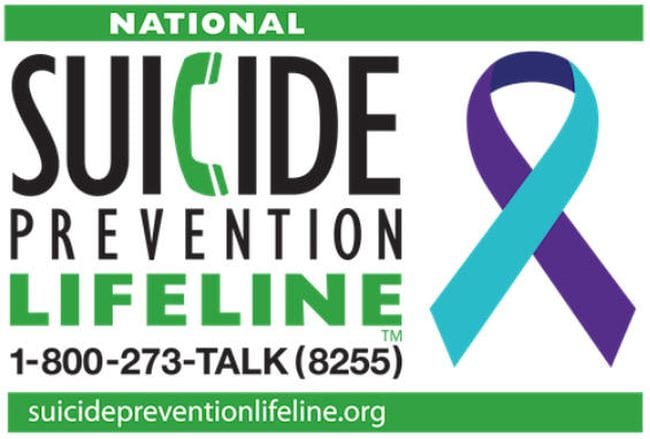
First and foremost, every teacher needs to be able to recognize immediate child- and teen-suicide risk and know how to handle it. According to the Suicide Prevention Resource Center (SPRC), these signs include:
- Talking about a desire to self-harm, including suicide.
- Looking for ways to kill themselves, like guns or pills.
- Talking about feeling hopeless or having no reason to live.
If you feel a student is at immediate risk, take these steps recommended for teachers by the SPRC:
- Don’t leave the student alone. If necessary ask other caring adults to step in.
- As soon as possible take the student to see your school’s mental health professional. Don’t send them on their own—walk them to the office.
- Tell the mental health professional exactly what you’re seeing and hearing. Don’t leave the student to report on their own; they’re likely to downplay what’s happening.
- Assist the mental health professional as needed. They can determine whether parents should be contacted or further action is required.
Get more information:
- National Suicide Prevention Lifeline, 1-800-273-TALK (8255)
- National Suicide Prevention Lifeline Online Chat
- Find a local crisis center
Get the numbers and facts on teen suicide.

In a November 2018 report, the Centers for Disease Control (CDC) indicated an increase in suicide across nearly all age groups and genders. Here are some takeaways on kids and teens in the years between 1999 and 2017.
- For girls age 10–14, suicide rates more than tripled, from 0.5 to 1.7 (per 100,000).
- Suicide rates for women age 15–24 nearly doubled, from 3.0 from 5.8 (per 100,000).
- The suicide rate for boys age 10–14 also increased, from 1.9 to 3.3 (per 100,000).
- Teenage boys and men age 15–24 have the highest rates among youth; their rates increased from 16.8 to 22.7 (per 100,000).
The CDC also noted that suicide continues to be more common in rural areas and small towns as opposed to bigger cities. In fact, by 2017, suicide rates in rural areas were nearly double that of large metropolitan areas. Girls attempt suicide more often than boys, but boys are more likely to actually die from suicide.
[contextly_auto_sidebar]
The numbers are sobering but serve as an important reminder that parents and teachers have a responsibility to help kids at risk for suicide whenever possible.
Get more information:
- Suicide Mortality in the United States, 1999–2017 (Centers for Disease Control)
- Suicide Statistics, American Foundation for Suicide Prevention
Understand that teachers are on the front line of teen-suicide prevention.
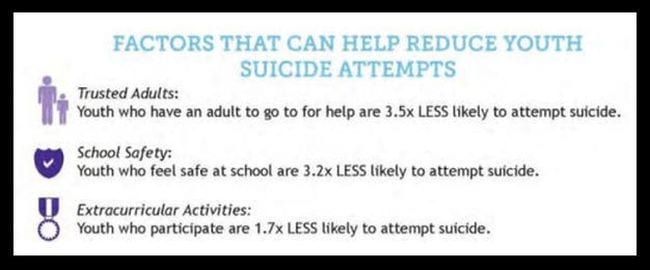
Source: Colorado Department of Public Health
Teachers have regular contact with the same students for months on end. They are often the first to detect behavior changes, mood swings, and unusual actions from a child or teen. It’s not uncommon for at least some students to trust a teacher more than a parent or relative. These are just some of the reasons teachers have the ability, and duty, to help prevent teen suicide.
New teachers are usually required to undergo suicide-prevention training. But all teachers (including elementary teachers) should expect to receive regular suicide-prevention training as part of their ongoing professional development. If your school doesn’t offer it, it’s time to ask. Most schools have their teachers renew their first aid certification every couple of years—suicide-prevention training is just as valuable and should be given just as often. There are multiple free programs available online (see below).
Teachers should also be sure to know whom their school mental health professional contact is. This might be a guidance counselor, school nurse, or other trained professional. Unfortunately, many schools no longer offer these services on campus, due to budget issues. If you’re not sure whom you should reach out to with concerns about a student, find out immediately. All schools should have policies in place that guide and support teachers in helping prevent suicide.
Get more information:
- The Role of High School Teachers in Preventing Suicide, Suicide Prevention Resource Center
- Suicide Prevention in Schools, American Foundation for Suicide Prevention (AFSP)
- Talk Saves Lives™, American Foundation for Suicide Prevention (AFSP)
- Society for the Prevention of Teen Suicide Online Training
Recognize what anxiety, depression, and suicidal thoughts look like in kids and teens.
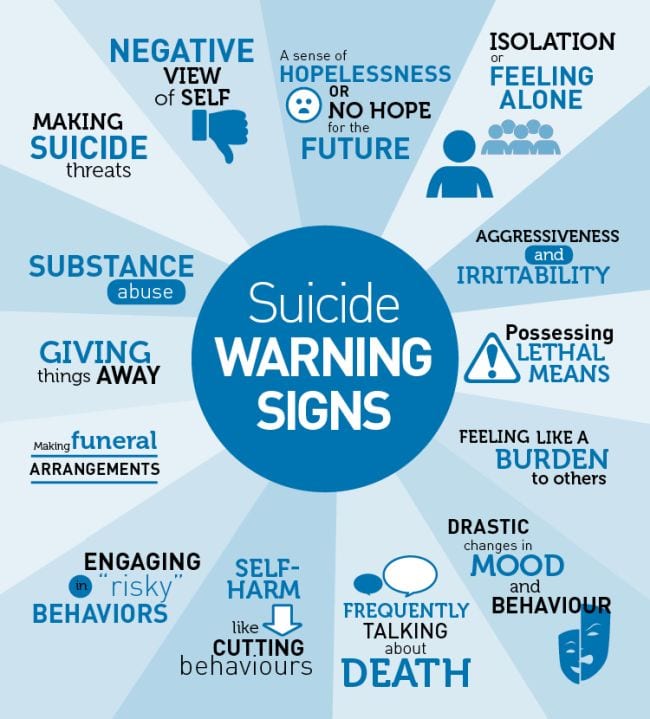
Source: Teen Health Matters
Sometimes suicidal behavior is easy to identify, but other times it’s harder to see. Catching depression and anxiety early and getting the appropriate treatment can prevent suicide in many cases. But depressed and anxious kids sometimes behave differently than adults, because they don’t understand what they’re feeling. Here are some signs to watch for. (This is not a definitive list. See the resources below for more.)
- Self-loathing. Take students seriously who talk (even jokingly) about hating themselves, feeling worthless, or having no reason to live. Also worrying: “People would be better off without me.”
- Reckless behavior. This might seem like a hallmark of the “invincible” teenage years, but it can also be a sign that a student feels their life has no value.
- Frequent, unexplained headaches, stomachaches, and similar pains. Kids often don’t recognize these as symptoms of anxiety or use them as excuses to avoid something they’re anxious about doing.
- Bouts of seemingly unprovoked anger, irritability, and meltdowns. Sure, all kids have some of these from time to time. But if you detect a pattern, it’s time to ask some questions.
- Fatigue and poor concentration. Anxiety often causes sleep loss, which affects the ability to concentrate on school work and other tasks. It can also lead to irrational behavior and poor decision-making.
- Substance abuse. Just like adults, kids and teens may use drugs and alcohol to escape.
Get more information:
- Warning Signs Your Teen Could Be at Risk for Suicide, Center for Parent & Teen Communication
- What Does Childhood Anxiety Look Like?, The Washington Post
- Teen Suicide, Johns Hopkins Medicine
- 7 Ways to Help Students Who Struggle With Anxiety
Keep all lines of communication open.
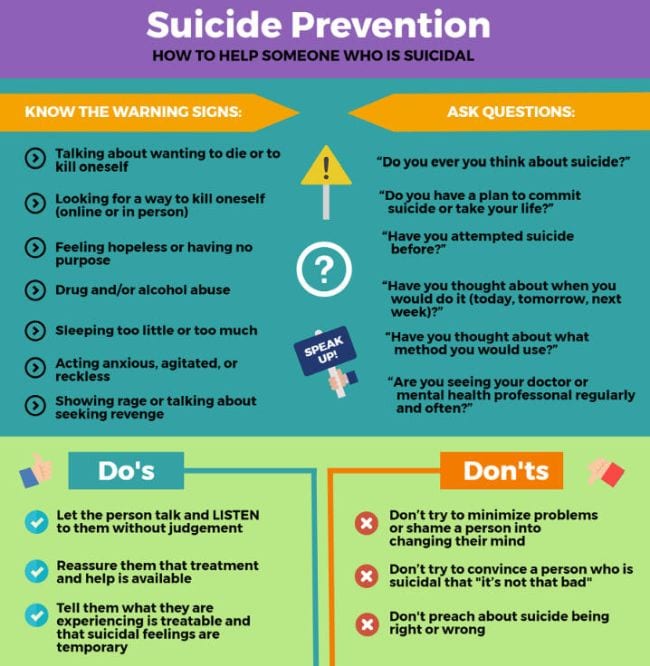
See the full infographic at: Anxiety and Depression Association of America.
Teachers often feel like they’re on the middle ground between students and parents, and this can be a good thing. Teachers can keep parents in the loop on behaviors they might not see at home. At the same time, students might feel more comfortable talking to a teacher than a parent about some issues. Teachers can help by remaining open to the concerns of both students and parents, reaching out to both as needed.
Take the concerns of your students seriously. If a teen comes to you and says they’re worried about a friend’s behavior, follow up. When you see a child with sudden negative behavior changes, try to find out what’s behind them. Sometimes, all you need to do is ask, “Hey, what’s going on?” and the floodgates open. Offer the chance to talk to the school medical health professional and seek expert help if you need it.
Teachers alone certainly aren’t responsible for preventing teen suicide. But they are an important link in the chain. Educate yourself and be prepared to help if the situation arises.
Get more information:
- Speaking to Your Teen About Suicide, Psychology Today
- What to Say to a Suicidal Teen, VeryWellMind
- How to Talk to Parents About a Child at Risk of Suicide, Centre for Suicide Prevention
- Suicide Prevention, Help Guide
Provide support if kid or teen suicide touches your school.
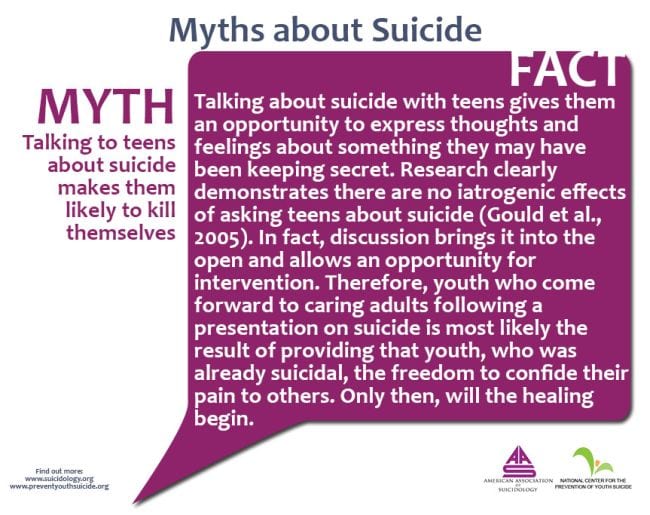
See more myths and facts from the American Association for Suicidology.
If the unthinkable happens, both students and teachers will need support to get through it. There’s some concern that sensationalizing suicide will encourage others to consider it (the copycat effect), but that absolutely doesn’t mean you can’t talk about it. Schools should provide easy access to medical health professionals and allow students to talk openly about their feelings and reactions. Don’t focus on the details of the suicide itself; instead, offer hope for others who might feel the same way.
Above all, teach students to reach out for help if they’re feeling hopeless. If they can’t talk to a parent, teacher, or mental health professional, make sure they have the number to the National Suicide Lifeline. If they would rather write than talk, there are text and chat lines available, too. Give them as many qualified resources as possible and make them easily and discreetly accessible.
Get more information:
- After a Suicide: A Toolkit for Schools, AFSP
- After Suicides of Parkland Survivors, Here’s What Educators Should Know About Supporting Students, Education Week
- Postvention as Prevention, SPRC
Want to talk about teen suicide or other difficult issues facing today’s teachers? Join the WeAreTeachers HELPLINE Facebook group.
Teachers struggle with anxiety and depression, too. Learn how to help yourself and your colleagues.
